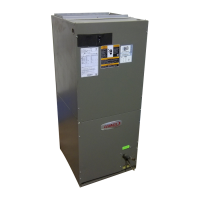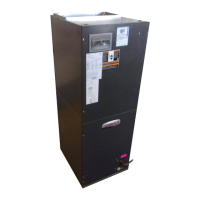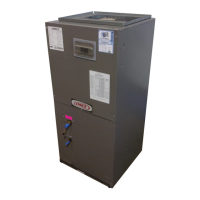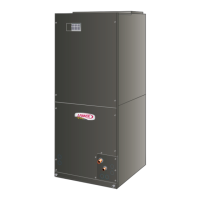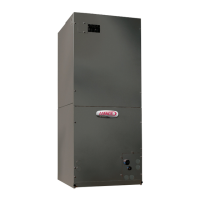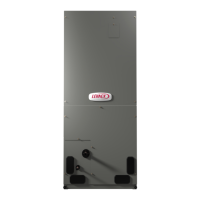Page 27
CBX40UHV
IV−OPTIONAL HUMIDITY CONTROL (A20)
ComfortSense
®
7000 thermostat
The Lennox ComfortSenset 7000 thermostat (shown
below) monitors indoor humidity conditions and creates a
dehumidification demand in response to indoor humidity
just as it creates a cooling demand in response to indoor
temperature. This thermostat adjusts compressor speed
and indoor blower speed to maintain humidity at a
comfortable level.
COOLING
TUE OCT 23 1:15PM
Principles of cooling with drier air
The humidity comfort range for humans is between 40 and
60 percent relative humidity (RH). 50% RH is the
recommended initial setpoint until personal comfort level is
established. The personal comfort level will vary with
humidity as with temperature. For example, if air at 75ºF
(24ºC) and 50% RH is changed to 60%, the air will feel
much warmer. Likewise, if the air is reduced to 40% RH, it
will feel much cooler.
Even when inactive, the body evaporates a large amount of
moisture away from the skin. This evaporation produces a
cooling effect (during wintertime, this phenomenon is called
wind−chill"). Dry air is capable of absorbing more moisture
away from the skin, thereby increasing the cooling effect.
When the ComfortSense 7000 thermostat senses that the
indoor humidity level is above the control setpoint, the
control places the indoor fan and outdoor unit in a
dehumidification mode. To produce drier air, the indoor fan
will slow down the speed of the air crossing the indoor coil.
Because the air is moving much slower than normal, the
indoor coil is allowed to remove moisture from the air (a
higher percentage of the air passing over the coil is cooled
to its dew point removing more moisture). At the same time,
the two-stage outdoor unit will switch to high−speed to
produce a colder indoor coil. The colder indoor coil and
slower moving air combine to produce drier supply air.
NOTE − The indoor blower speed is reduced in order to slow
the air speed across the indoor coil. The supply air exiting
the unit may not feel as forceful. This is normal. Remember
that when the unit is in dehumidification mode, the comfort
level is increased because the unit is producing cooler, drier
air.
The exact sequence of operation to produce cooler, drier air
is described in the following section.
Other conditions adversely affecting
ComfortSense 7000 thermostat performance
Blower speed selection can adversely affect ComfortSense
7000 thermostat performance. Higher blower speeds
should be selected to provide maximum sensible cooling,
while lower blower speeds should be selected to provide
maximum humidity removal. Refer to the air handler and
thermostat installation instructions.
It is recommended that the indoor blower be left in AUTO
mode at all times. During dehumidification mode, the indoor
coil and drain pan may become saturated with moisture. If
the indoor blower is left in ON mode, much of that moisture
can be re−evaporated into the living space between
thermostat demands. This can create a constant demand
for humidity removal and may cause extended compressor
run times. Refer to table 11 for jumpers per application.
Table 11
Jumpers Required
Humidity
Control
Outdoor Unit
type
Compressor
type
Jumpers
required
OFF Heat Pump one−stage DS to Y1 &
Y1 to Y2
two−stage DS to Y1
Condensing
Unit
one−stage DS to Y1 &
Y1 to Y2 &
O to R
two−stage DS to Y1 &
O to R
ON Heat Pump one−stage Y1 to Y2
two−stage None
Condensing
Unit
one−stage Y1 to Y2 &
O to R
two−stage O to R
Operation
Dehumidification is provided only when the thermostat is in
cool mode and may be set in the range of 45% to 60% RH.
Dehumidification D terminal wires to variable speed blower
(reverse logic/active on low signal 24VAC). When the unit is
in heating mode, the dehumidification function is off. The
default mode for dehumidification is OFF and needs to be
activated during installation.
The D terminal is active whenever the ComfortSense
®
7000 thermostat is powered, EXCEPT when there is a
dehumidification demand. This means that the D terminal
has 24VAC on it even in HEAT and OFF modes.
BASIC mode
Dehumidification only with a cooling demand. COOL is on,
then D is active (reverse logic off), and G comes on (if not
already on), Y1 and Y2 (if available) is on.
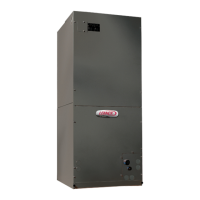
